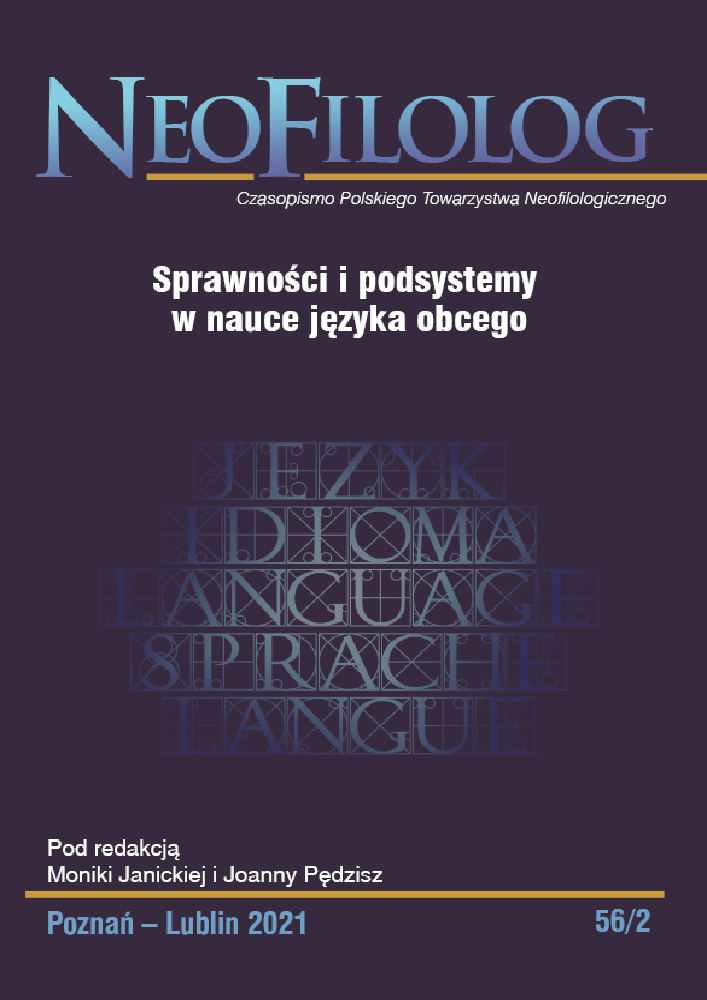Résumé
The article reports on an action research study which uses reformulation as its key instrument. The aim of the study was to identify the individual characteristics of acquisition of complex structures in Polish (native language) and English (foreign language) by children with speech and language deficits, learning in an inclusive environment at the upper primary level. The analysis of the gathered data focuses on Polish and English structures used by special needs students and mainstream students in their inclusive educational environment, and on the students’ ability to build/reconstruct a narrative structure – according to the unique qualities of the input text. The observed trends help to plan and organise the teaching process, which also includes the rehabilitation of speech and language in a foreign language lesson.
Références
Adam J.-M. (1984), Le récit. Paris: Presse Universitaire de France.
Baglieri S., Shapiro, A. (2017), Disability Studies and the Inclusive Classroom. Critical Practices for Embracing Diversity In Education. New York: Routledge Library Edition.
Brillante P., Nemeth K. (2018), Universal Design for Learning in the Early Childhood Classroom. Teaching Children of all Languages, Cultures, and Abilities, Birth – 8 Years. New York: Routledge Library Edition.
Europejski system opisu kształcenia językowego: uczenie się, nauczanie, oce-nianie (2003). Warszawa: CODN.
Karpińska-Szaj K. (2013), Nauczanie języków obcych uczniów z niepełnosprawnością w szkołach ogólnodostępnych. Poznań: Wydawnictwo Naukowe UAM.
Karpińska-Szaj K., Wojciechowska B. (2016), Przeformułowanie w przyswajaniu i uczeniu się języków: specyfika i funkcje odtwarzania opowiadania. „Neofilolog”, nr 46/1, s. 109–125.
Karpińska-Szaj K., Wojciechowska B., Lewandowska A., Sopata A. (2019), Reformu-lation in foreign language learning. Poznań: Wydawnictwo Naukowe UAM.
Klein W. (1989), L’acquisition de langue étrangère. Paris: Armand Colin.
Krasowicz-Kupis G. (2004), Rozwój świadomości językowej dziecka. Teoria i praktyka. Lublin: Wydawnictwo UMCS.
Martinot C. (2012), De la reformulation en langue naturelle, vers son exploitation pédagogique en langue étrangère: pour une optimisation des stratégies d’apprentissage. „Synergies-Pologne”, nr 9, s. 63–76.
Martinot C. (2013), Les phénomènes complexes de la langue sont-ils complexe pour tous les enfants ? „Approche Neuropsychologique des Apprentissages chez l’Enfant”, nr 124, s. 279–287.
Martinot C., Gerolimich S., Bosniak-Botica T., Tutunjiu E. (2012), Un phénomène complexe d’acquisition en langue maternelle: le cas des relatives dans une perspective translinguistique, (w:) Paprocka-Piotrowska U., Martinot C., Gerolimich S. (red.), La complexité en langue et son acquisition. Lublin: Towarzystwo Naukowe KUL, s. 169–212.
Martinot C., Bošnjak Botica T., Gerolimich S., Paprocka-Piotrowska U. (red.) (2018), Reformulation et acquisition de la complexité linguistique. Perspective interlangue. London: ISTE, Collection Sciences Cognitives.
Michot M. E. (2015), La complexité linguistique et l’acquisition du français et de l’anglais. „Círculo de Lingüística Aplicada a la Comunicación”, nr 63, s. 3–8.
Noyau C., Vasseur M.T. (1986), L’acquisition des moyens de la référence temporelle en français chez des adultes hispanophones. „Langage”, nr 84, s. 133–158.
Olechowska A. (2016), Specjalne potrzeby edukacyjne. Warszawa: PWN.
Paprocka-Piotrowska U. (2016), Kompetencja narracyjna i jej rozwój w języku francuskim jako obcym na poziomie szkoły średniej. „Języki Obce w Szkole”, nr 16/2, s. 35–42.
Licence
© Katarzyna Karpińska-Szaj, Agata Lewandowska 2021

Ce travail est disponible sous licence Creative Commons Attribution - Pas de Modification 4.0 International.
Auteurs :
Les auteurs de textes acceptés pour publication dans la revue Neofilolog sont tenus de remplir, signer et renvoyer à l'adresse de la rédaction, un accord sur l'octroi d'une licence gratuite pour les œuvres, avec obligation d'accorder une sous-licence CC.
En vertu de cet accord, les auteurs des textes publiés dans la revue Neofilolog accordent à l'Université Adam Mickiewicz de Poznań une licence non exclusive et gratuite et permettent l'utilisation de la sous-licence Creative Commons Attribution-NoDerivatives 4.0 International (CC BY-ND 4.0).
Les auteurs se réservent le droit de disposer librement de l'œuvre.
Utilisateurs :
Les utilisateurs d'Internet intéressés ont le droit d'utiliser les œuvres publiées à partir de l'année 2017 sous réserve des conditions suivantes :
- reconnaissance de la qualité d'auteur - l'obligation de fournir des informations sur la qualité d'auteur, le titre, la source (liens vers l'œuvre originale, DOI) et la licence, ainsi que l'œuvre distribuée ;
- sans créer d'œuvres dérivées - l'œuvre doit être conservée dans sa forme originale, p. ex. les traductions ou les interprétations ne peuvent être distribuées sans le consentement de l'auteur.
Tous les textes publiés sont soumis au droit d'auteur.
Autres :
L'Université Adam Mickiewicz de Poznań se réserve le droit à la revue dans son ensemble (mise en page, forme graphique, titre, conception de la couverture, logo, etc.).
.

